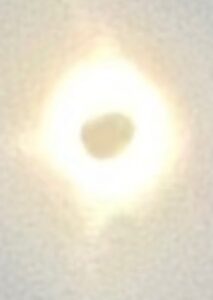Is it me? It’s not you… is it? No, it’s beer. When beer sales peak, the news gets a bit sleepy or at least played out as expected. LCBO strike got settled. Beer in Canada is still expensive. Biden stepped aside. The French fascists were humilated… again. Sure, the back channel comments about the winding up of GBH continue to flow in – but nothing I would share to you lot. Some write for pay. Me, I write for gossip. I think Martin captured the zeitgeist of the week perfectly with this image above from his trip to take in the delights of the Church of St Mary Magdalene in Yarm.
Which leads to the question of the week, as posed by Stan on Monday when he responded to my comment last week that I think of him as my ever absent desk editor:
I am embarrassed, flattered, and a little surprised (perhaps skeptical) by the idea he does the sifting for me. The takeaway, to his credit, is a reminder of something all writers should remember: who the heck they think they are writing for.
Who or what do you write for? The reader? The commissioning editor? The next commissioning editor? The bills? The long dead relative who told you that you’d never amount to anything? I joke about things but I really have only been writing for myself for years. The beer trade is a benign sideshow that lets me explore ideas in an innocuous way. Ideas about life, business, quality, ethics… the whole shebang. It’s all right there. By the way, did you know a shebang was a rough hut of the Civil War era or a frontier settler? Me neither. One has to be careful about certain words.
Speaking of words, Jordan was out there recently wandering lonely as a cloud, not hunting out daffodils so much as dandelions to do some unpacking, dissecting and extractions to ‘splain a thing or two:
Dandelion has GLVs (hexenol), but that is to be expected since it has green leaves. It’s complex in that the different parts of the plant have their own properties. Harold McGee refers to the component smells as “light, fresh, and watery,” but we’re thinking about the entirety of the palate and not just the aroma. In terms of aroma, we have some of the same makeup as clover. Phenylethanol and benzaldehyde. There’s also Nerolidol, which is slightly woody and barky, which makes sense when you think of the rigidity of the stem. When the stem breaks, the dandelion’s defense method is to secrete latex, which is found mostly in the root system of the plant. The latex is not only bitter, but alkaloid, and polyphenolic. If you pick a dandelion to hold under someone’s chin, you’re going to get aroma from both the flower and the stem.
Yes, yes… outside of the Greater Toronto Area kids used buttercups to hold to a chins. But the point is made. There is science right there. Smelly tasty science. Yes, there. And there as well…. ‘s’tru’. Even if “…phenylethanol and benzaldehyde… There’s also Nerolidol… “ sounds like a particularly challenging point in a Gilbert and Sullivan libretto.
Before the doors close, GBH published an interesting story by Yolanda Evans on the practice of giving “libation” globally and also particularly in Black American culture:
“I think hip-hop just popularized [libations] in a way where we were given the language to talk about the celebrations of life that maybe we didn’t have before,” says Gates. “It’s not specific to a particular generation—hip-hop only happened 50 years ago, while we’ve been in this country for centuries,” she adds. In some ways, the genre transformed the ritual from a private and personal thing to an act so popular it eventually became removed from its roots—eventually, people everywhere, and especially in the African-American community, would pour one out for their homies without knowing they’re performing an old boozy ritual with roots that go back several thousands of years.
The piece expands much on the 2015 article in VinePair and, for me, it’s an interesting exploration a familiar thing because we Highland Scots do it, too. But it’s part of what my Reverend father would call the greater “heedrum hodrum” aka the pre-Christian rituals that hang on. But in that context it’s not so much about remembrance as thinning the ether between here and there, now and then. Want to have a moment with Grannie to share a thought? Pour a little of the good stuff on the ground.
Tasting note of the week: “…distressingly grey…”
Speaking of VinePair, David Jesudason wrote an interesting piece for that fine journal in which his powers are on full display. I love how he places himself in stories, rejecting that more formulaic approach that we suffer along with too often. Consider this passage:
He’s all for mixing Guinness when done well but prefers to use bottled Guinness over widget beer cans or draft kegs in pubs for logistic reasons, such as lower carbonation. “Bottled Guinness has a different bite, of course,” he adds. When I press-gang Gaurav Khanna, the publican at the desi pub Gladstone in south London, into mixing numerous Guinness with soft drinks, he at first struggles with wastage caused by the stout’s carbonation. After a few pints mixed with Irn-Bru and some Gonsters, though, he nailed it. (At the end of the session we had to negotiate hard over my tab because we lost count of the amount of Guinness that was “tasted,” drunk or discarded.)
But no mention of stout and port, 2012’s sensation. Why?
News out of the UK related to the affirmation of the new government’s intention to impliment its predecessor’s public venue protection standards in Martyn’s law. Sarah Neish in The Drinks Business shared the likely implications for pubs and other parts of the UK hospitality industry:
… premises are unlikely to be expected to undertake physical alterations or fork out for additional equipment… measures are expected to include: Evacuation – how to get people out of the building; Invacuation – how to bring people into the premises to keep them safe or how to move them to safe parts of the building; Lockdown – how to secure the premises against attackers, e.g. locking doors, closing shutters and using barriers to prevent access; and Communication – how to alert staff and customers, and move people away from danger. “Additionally staff will need to understand these measures sufficiently to carry them out if needed,” Grimsey tells db, which suggests there will need to be an element of staff training for front-of-house employees of Standard Tier venues.
Sensible stuff. These are different times. Speak of these times, Katie wrote an explanation of “underconsumption core” this week in her newsletter The Gulp, a concept which may explain my dedicate use of a dull manual rotary lawnmower:
Underconsumption core exists because even the most exuberant of haulfluencers are starting to feel the constrictions of what is basically a national money shortage. When Broccoli is £1.20 a head in Lidl (one pound twenty pence!! for broccoli!!), there are many other things that have to get cut from our monthly budgets. Nights out become more infrequent. Takeaways become frozen pizzas. Beer turns into slabs of whatever tinnies are on offer at Tesco. We do what we can to keep ourselves afloat when the weekly shop increases by more than 20% over a year.
Reality. It may be a variation on another thing – the return to basic beer. Don’t tell Forbes, by the way, which published a piece by one of the 198,349 beer columnists (no, not AI generated at all, no way) they seem to have on the payroll that offered this astounding statement:
Researchers highlighted the increasing popularity of craft beer and the emergence of more independent breweries, reflecting evolving consumer preferences, especially among younger consumers of legal drinking age in local markets. These breweries are often at the forefront of innovation, offering more flavors and styles that appeal particularly to millennials and Generation Z.
Right. Back on planet Earth, when someone not really at the core of a scene like the former style director of Esquire, Charlie Teasdale, takes the time to give craft beer a mocking kick it is starting to feel like the proper response is, what… pity?*
… like supporting a football team through a massive, slightly grubby commercial takeover, I stayed the course. I never wavered in my dedication to stupidly named pale ales and unorthodox beers. Even a jug of pseudo-craft – a beer brewed by a corporate outfit but marketed as a local endeavour – was better than, say, a Moretti or a Heineken. They were for drinkers, and I was a gourmand.
VinePair may well have gone next level… again, joining this latest pile-on according to Maggie Hennessy. And whereas Mr. Teasdale has moved back to popular lagers, Ms. H is touting something called “lifestyle” beer but mainly to beat the word “hipster” wtith a very big stick… over and over.** Strike me as all a bit of excessively early liminal labeling syndrome. Perhaps best to leave this phenomenon alone until it all settles down a bit and clarifies. By contrast, Courtney Iseman slides a more deftly phased zing in the larger context of her very comprehnensive survey of the use of rice by better brewers:
That industry maturation, and the decreased pressures of toxic fandom—no one’s boycotting your brewery anymore if you sell shares to a corporate overlord, nor if you put rice in your beer—has allowed craft brewers more freedom to find a place for the grain.
Toxic fandom! We are now a long way from the “beer community” fibbery. [Note: as stated in the story, it was the craft brewers were the ones who shit on rice but now it’s us beer buyers who were being toxic for taking up the brewers’s PR (touted by beer writers) as the great cause.] Ron don’t care. Ron is spending much of the month with family in South America. He is sending in posts from the field that look like he’s tied up the radio operator and highjacked a distant railway station deep inland, relying on only direct current and Morse Code to send out terse missives like this one entitled “Loving Santiago“:
The kids, too. We get to ride the metro everywhere. They drink beer, I drink pisco sour. We get to shiver together in the unheated pubs. It’s like being back in the 1970s. But in a good way. Montevideo tomorrow.
That’s the whole post? So unRon, Ron is being. Where the hell are the breakfast buffet photos, Ron?!?!?!
Speaking of a buffet, Rachel Hendry has studied the world of (call them what you will) thin bits of potato fried in oil and shared the extensive results in Pellicle this week. I particularly like the polite “don’t be an arsehole” notice to readers:
I have then chosen ten styles and flavours to explore within each section, with more precise pairings given as examples for each. I have defined crisps as a potato or potato adjacent snack that tends to be found behind the bar or in the crisp aisles of a shop, and I have defined beer styles as you might see indicated on the list displayed in a pub or taproom. There is only so much one woman can cover and I have forgiven myself for the detail and genres missed. I trust you to have the grace to forgive me, too.
And… when did PBR become hipster cool? I was interested for what I consider pre-hipster reasons in 2006. This 2014 HuffPost article traces the story… with graphs!
…something changed, and PBR was suddenly the hipster’s choice at bars and barbecues everywhere. Sales jumped by 20.3 percent in 2009 and continued to rise steadily over the next few years, according to Beer Marketer’s Insights. By 2013, Americans drank more than 90 million gallons of PBR, according to data from Euromonitor, which is nearly 200 percent more than they did in 2004.
“Rise Steadily” is one of those hints that the tipping point people can just remain seated.
Fine. That is it. And with that this and those other thats too … now we roll the credits… well, the credits, the stats the recommends and the footnotes and the many ways to find good reading about beer and similar stuff via any number of social media and other forms of comms connections.** Want to keep up with the news before next Thursday? Check out Boak and Bailey every Saturday and Stan on the job each and every Monday. Elsewhere go look at then listen to Lew’s podcast. And get your emailed issue of Episodes of my Pub Life by this year’s model citizen David Jesudason on the odd Fridays. And Phil Mellows is at the BritishBeerBreaks. Once a month, Will Hawkes issues his London Beer City newsletter and do sign up for Katie’s now revitalised and wonderful newsletter, The Gulp, too. Ben’s Beer and Badword is back with all the sweary Mary he can think of! And check out the Atlantic Canada Beer Blog‘s weekly roundup. There is new reading at The Glass which is going back to being a blog in this weeks best medium as message news. Any more? Yes! Check to see the highly recommended Beer Ladies Podcast. That’s quite good. And the BOAS podcast for the bro-ly soon celebrating a 10th anniversary… or really a 9 1/2th given the timeline . And the long standing Beervana podcast …except they have now stood down. Plus We Are Beer People. The Boys Are From Märzen podcast appears suspended as does BeerEdge, too. But not Ontario’s own A Quick Beer. There is more from DaftAboutCraft‘s podcast, too. All About Beer has introduced a few podcasts… but some may be losing steam… until… Lew’s interview! And there’s also The Perfect Pour. Plus follow the venerable Full Pint podcast. And the Craft Beer Channel on Youtube. The Moon Under Water… is gone which is not surprising as the ask was $10 a month. Pete Brown’s costs a fifth of that but is writing for 47 readers over there. There was also the Beer O’clock Show but that was gone after a ten year run but returned renewed and here is the link! Errr… nope, it is gone again.
*h/t The Tand.
**Stan gave sound advice (see what I did there?): “I think the relationship, if there is one, between hip and hipster has me confused. Were the bike messengers who drank PBR hip, hipsters, or something else? What PBR itself ever hip?“
***This week’s update on my own emotional rankings? Facebook still in first (given especially as it is focused on my 300 closest friends and family) then we have BlueSky (132) rising up to maybe… probably… pass Mastodon (932) in value… then the seemingly doomed trashy Twex (4,485) hovering somewhere well above my largely ignored Instagram (160), crap Threads (52) with Substack Notes (1) really dragging up the rear.














